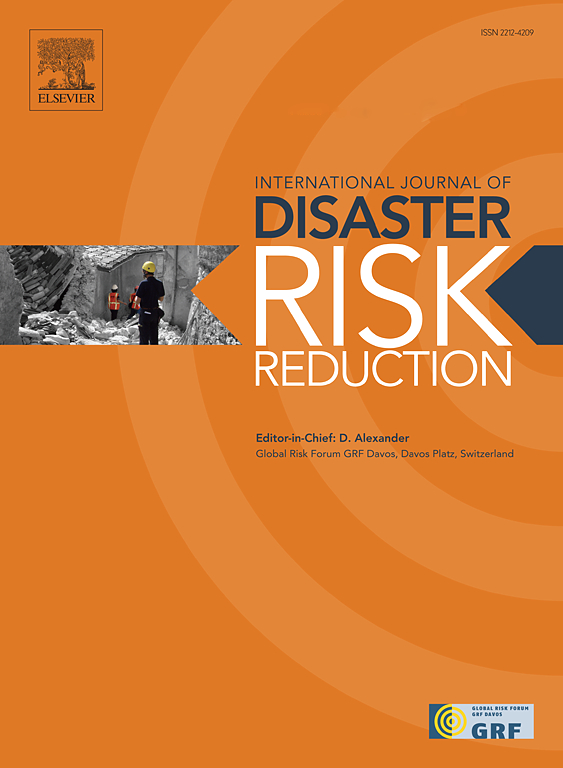利用洪水易感性和基于树的机器学习模型的热带气旋风险预测框架:广东省县级直接经济损失预测
IF 4.2
1区 地球科学
Q1 GEOSCIENCES, MULTIDISCIPLINARY
International journal of disaster risk reduction
Pub Date : 2024-11-01
DOI:10.1016/j.ijdrr.2024.104955
引用次数: 0
摘要
热带气旋(TC)以强风、暴雨、风暴潮和洪水为特征,给全球沿海地区造成了巨大的经济损失和人员伤亡。然而,现有的热带气旋风险预测框架往往未能充分考虑洪水的直接影响。在本研究中,我们建议将洪水易感性这一洪水预警系统的重要组成部分纳入热带气旋风险预测框架。以广东省为重点,我们采用了四种基于树的机器学习(ML)模型(随机森林、极端梯度提升、轻梯度提升机和分类提升)来预测基于洪水易感性、海洋气象数据和脆弱性数据的县级直接经济损失(DELs)。这些 ML 模型在 896 个样本的数据集上进行了训练和测试,取得了很高的预测精度,预测值和观测值之间的皮尔逊相关系数超过 0.81。在这四个模型中,轻梯度提升机的性能最佳,达到了最高的 R 值和 R2 值,以及最低的 MSE 值、MAE 值和 MedAE 值。通过与直接纳入环境因素的传统方法进行比较,验证了洪水易感性的整合。此外,所提出的热带气旋风险预测框架还被应用于预测 2018 年超强台风 "曼克胡特 "的影响,说明了其在 "实时 "热带气旋风险评估方面的潜在能力。这些 "实时 "DEL 预测不仅能估计潜在损失,还能促进及时干预,从而提高模型在防灾和救灾方面的实用价值。本文章由计算机程序翻译,如有差异,请以英文原文为准。
A tropical cyclone risk prediction framework using flood susceptibility and tree-based machine learning models: County-level direct economic loss prediction in Guangdong Province
Tropical cyclones (TCs), characterized by strong winds, heavy rainfall, storm surges, and flooding, have caused significant economic losses and fatalities in coastal regions globally. However, existing TC risk prediction frameworks often fail to adequately account for the direct impacts of flooding. In this study, we propose integrating flood susceptibility, a critical component of flood early warning systems, into TC risk prediction frameworks. Focusing on Guangdong Province, we employ four tree-based machine learning (ML) models (random forest, extreme gradient boosting, light gradient boosting machine, and categorical boosting) to predict county-level direct economic losses (DELs) based on flood susceptibility, oceanographic-meteorological data, and vulnerability data. These ML models are trained and tested on a dataset of 896 samples, achieving high prediction accuracies, with Pearson correlation coefficients exceeding 0.81 between the predicted and observed DEL values. Among the four models, the light gradient boosting machine demonstrates the best performance, achieving the highest values of R and R2, and the lowest values of MSE, MAE, and MedAE. The integration of flood susceptibility is validated by comparing it with traditional methods that directly incorporate environmental factors. Furthermore, the proposed TC risk prediction framework is applied to forecast the impacts of Super Typhoon Mangkhut in 2018, illustrating its potential ability for “real-time” TC risk assessments. These “real-time” DEL predictions not only estimate potential losses but also facilitate timely interventions, thereby enhancing the practical value of the model for disaster prevention and response.
求助全文
通过发布文献求助,成功后即可免费获取论文全文。
去求助
来源期刊

International journal of disaster risk reduction
GEOSCIENCES, MULTIDISCIPLINARYMETEOROLOGY-METEOROLOGY & ATMOSPHERIC SCIENCES
CiteScore
8.70
自引率
18.00%
发文量
688
审稿时长
79 days
期刊介绍:
The International Journal of Disaster Risk Reduction (IJDRR) is the journal for researchers, policymakers and practitioners across diverse disciplines: earth sciences and their implications; environmental sciences; engineering; urban studies; geography; and the social sciences. IJDRR publishes fundamental and applied research, critical reviews, policy papers and case studies with a particular focus on multi-disciplinary research that aims to reduce the impact of natural, technological, social and intentional disasters. IJDRR stimulates exchange of ideas and knowledge transfer on disaster research, mitigation, adaptation, prevention and risk reduction at all geographical scales: local, national and international.
Key topics:-
-multifaceted disaster and cascading disasters
-the development of disaster risk reduction strategies and techniques
-discussion and development of effective warning and educational systems for risk management at all levels
-disasters associated with climate change
-vulnerability analysis and vulnerability trends
-emerging risks
-resilience against disasters.
The journal particularly encourages papers that approach risk from a multi-disciplinary perspective.
 求助内容:
求助内容: 应助结果提醒方式:
应助结果提醒方式:


